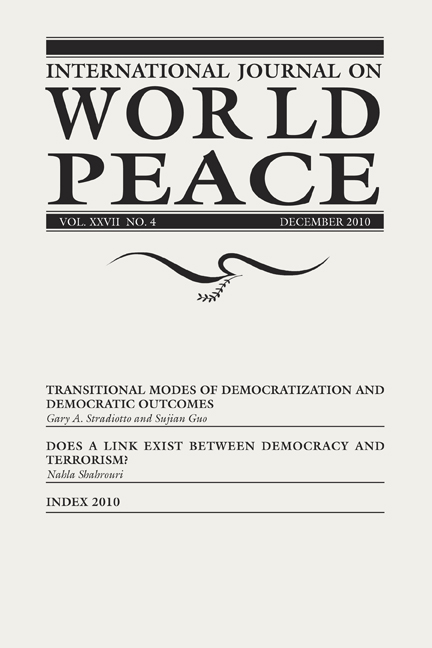This issue of IJWP focuses on democracy: how to establish it and its relation to violence. We continue from the September issue’s last article “Internal vs. External Requisites of Democracy” by Kunihiko Imai with two additional research articles related to democracy.
The first article, by Gary A. Stradiotto and Sujian Guo, is on
“Transitional Modes of Democratization and Democratic Outcomes.” This is
particularly significant for people who make plans to implement
democracy, since how democracy is implemented, and by whom, is very
important in determining whether a democracy will survive ten years or
longer.
While the conclusion that democracies work best when they are created
out of cooperative transitions, rather than by imposition, may seem
common sense, many of today’s leading countries and international
organizations still try to impose democracy on people living in
non-democratic societies. Perhaps this research will help bolster
arguments against many of the efforts by global elites to impose
democracy through regime change or as a criterion for receiving
international loans or assistance. Democracy is something that people
have to feel they own, that they control, and that allows them to pursue
an unfettered life.
Stradiotto and Guo examine four modes of transition: (1) Conversion—when the elites in power take the lead in democratization “from above,” (2) Cooperative—democratization by the joint action by government and opposition groups, (3) Collapse—when a regime collapses or is overthrown and change is “from below,” and (4) Foreign Intervention—when foreign military removes a regime and attempts democratization “from outside.”
There are numerous historical examples of democratic transition, and the authors draw upon 57 democratic transitions that took place over a period of 570 years. One particular conclusion is the importance of power balance in pacts. The proponents and opponents of viability of pacts may have focused on different types of pacts. Pacts forged with an existing regime to convert it to a more democratic system do not have as much success as when those in an existing regime are on equal footing with opponents and other groups, creating a genuinely cooperative government.
One obvious conclusion to be drawn related to the United States is that the United States itself was formed in a cooperative arrangement among thirteen states with distributed power, whereas attempts to impose democracy in Haiti, Iraq, or Afghanistan did not follow this pattern. Thus, if the ultimate goal is to see genuine and lasting democracies in other parts of the world, then the strategies frequently employed by U.S. administrations are inappropriate for the ends sought.
The second article, by Nahla Shahrouri, is titled “Does a Link Exist Between Democracy and Terrorism?” This article begins by noting that the existing literature has two different viewpoints. Some argue that political and economic oppression, and the lack of free expression, can cause terrorism and that democracy and freedom will allow the would-be terrorists to pursue their lives unimpeded and that terrorism will no longer be necessary. Others argue that terrorists exploit democracy and that fighting terrorism requires removing civil liberties and making the country less democratic.
Shahrouri’s study concludes that one way to reduce terrorism over the long run is to increase democratization. There is a negative correlation between democracy and terrorism. However, she agrees with the first article’s conclusion that “forcing democratization on a state that is resistant may leave us in a larger predicament than we are in now.” This is the problem facing the U.S. in Afghanistan and Iraq. She concludes that improving wealth and health benefits is not nearly as effective as democratization. People want to live their own lives, not those envisioned by elites.
Taken together, the research of Imai, Stradiotto and Guo, and Shahrouri provide a good argument that democracy is something freely created by a people who want it and are capable of it. Democracy is not something that can be imposed by new laws or free elections. While new laws and free elections belong to democratic transitions, they are neither the cause nor guarantee of genuine democracies.
Gordon L. Anderson
Editor-in-Chief




